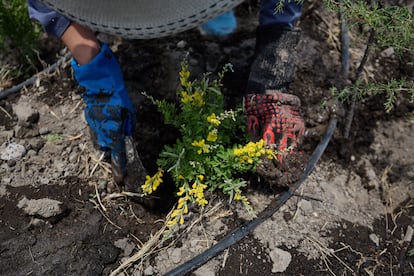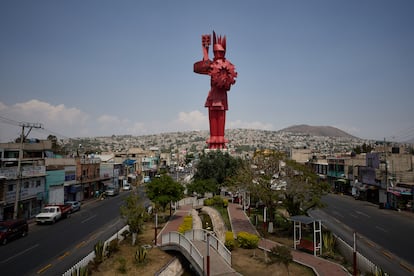In English, the Japanese concept satoyama translates as “village” and “mountain.” These are rural environments where communities manage forests and farmland based on a sustainable system, harnessing their resources without harming them, in a kind of sacred pact between humans and nature for living in harmony. A notion that today, more than ever, needs to be applied in Nezahualcóyotl, a municipality in the State of Mexico, where gray asphalt is the rule and green is the exception. Nezayork, as it is jokingly known, burns to the rhythm of cumbia music blasting loudly in its streets, which were built on what was once Lake Texcoco. Now they are, literally, on salt.
After World War II, Japan poured all its efforts into an ambitious economic recovery plan, with one consequence: urbanization and industrial growth broke that pact with nature throughout the country, including the satoyama. The environmental crisis began to manifest itself in alarming levels of air and water pollution, and illnesses among residents. But in the 1970s, the government passed environmental laws to mitigate the situation. In 1973, it decreed that factories of a certain size must allocate 20% of their surface area to green spaces.
Akira Miyawaki, a botanist born in Okayama, had spent years cataloging his country’s native species. His expertise made him a key figure in companies’ attempts to comply with the new environmental regulations. His first job was with Nippon Steel, a powerful steel manufacturer, creating forests at its production plants. The method quickly spread to other companies such as the Tokyo Electric Power Company, an energy producer, and the Honda Motor Company, a key player in the automotive industry.
Thus was born the Miyawaki method, a forestation technique that creates fast-growing, highly biodiverse native forests in the middle of urban areas, or even on deteriorating land. This planting style forces vegetation to compete for resources, accelerating its growth. A forest planted using this technique can grow in 30 years and requires no maintenance after three years.
The Miyawaki method has been replicated in Italy, India, Brazil, Chile, and Jordan. And now it has arrived in Nezahualcóyotl, a municipality in the eastern part of the State of Mexico and, in practice, a suburb of the sprawling Mexican capital, which on May 6 welcomed volunteers and professionals to its Technological University to bring this new forest to life on a 600-square-meter unused lot.
Nicolás Corral, a Chilean forester who led the planting of this forest, explains that the process begins with a backhoe that “decompresses the soil and gives it a final turn to loosen it.” Then, they incorporate organic matter — compost and urban agricultural and industrial waste — to “revive” it. The planting is done at a high density, with three plants per square meter, because, according to Corral, “the forest does not regenerate in squares or grids as in conventional reforestation, which comes from a mathematical approach to agricultural production.” This method of planting, he says, seeks to imitate the dynamics of the natural forest and thus “maximize survival, growth, and interaction between fauna, flora, and fungi.”
In a few years, this space could experience temperatures between 10 and 15 degrees Celsius lower than its urban surroundings, says Corral. “More rainwater will infiltrate, [there will be] less runoff, and that will accelerate the spontaneous recovery of the soil.” The forest will also function as a source of seeds dispersed by birds, a living nucleus amid the concrete. “Here there was nothing but weeds; now it will be a space for restoration and environmental education.”

In total, 25 native species and 1,500 plants have been planted. According to Gabriel Orrego, a Chilean forester, species with different ecosystem functions were sought: “Plants that know how to find phosphorus in the soil, that are nitrogen fixers, that bring in pollinators. The greater the diversity, the greater the ecosystem complexity, and that means resilience.” To this end, agaves, opuntias, cylinder opuntias, and cardones, species native to arid zones like this one, have been used. Also, brooms and dodoneas, which pave the way for more leafy vegetation. Tepozanes, ash trees, and colorines have been introduced, as well as some key herbaceous plants, such as milkweed, to promote pollination.
María Guadalupe Morales works in the university’s administrative services department. On planting day, she guides the volunteers. She moves with ease throughout the land: she gets her hands dirty in the soil, answers phone calls, gives directions, and observes, with satisfaction, how this land, which no one had ever noticed before, is being transformed. Lupita, as her colleagues call her, points to the hills in the distance, crowded with a grayish patch of houses. She remembers her adolescence, when she climbed those still-green mountains and there wasn’t much asphalt: “All the crops and vegetation are gone. There’s a lot of pavement now, and it all happened as a result of colonization. A lot of people started migrating, and everything was concentrated on this side. Today, there are a few trees on the streets, but nothing more,” she says.
The origins of Neza, as the municipality is known, explain the ecological challenges it faces. The first inhabitants, migrants from Guerrero, Michoacán, Jalisco, Oaxaca, and Puebla, began settling on the shores of Lake Texcoco. Over time, their homes were built on the dried-up lake, a saline and hostile terrain. The expansion was rapid, with no time for planning, and with little regard for the conservation of green areas.

Today, 62 years after its official creation, Neza experiences the so-called “heat island” effect, which concentrates high temperatures. It is also one of the most densely populated municipalities in the country, which exacerbates its environmental challenges. The effect, explains Andrea Guzmán, urban planner and manager of the creation of this forest in Mexico, is intensified by the accumulation of dark, hard surfaces such as pavement, industrial surfaces, cars, and air conditioners. “These are areas without foliage, where there are no plants or trees to absorb heat. Instead, the pavement retains and reflects it, causing the temperature to rise even further.”
For this reason, the planting of this first “pocket forest,” as the Japanese botanist’s method has also been called, is a symbol for the community and for the students. Guzmán, who worked hand in hand with SUGI, a global platform dedicated to creating these forests in urban areas, knows that this isn’t a complete solution to the problem, but it is a step forward: “The Miyawaki forests aren’t going to solve all our problems,” she says. “It’s not a magic wand, but it will solve one of the thousands of problems we have. We need a system of solutions, and this is one of them.”
Sign up for our weekly newsletter to get more English-language news coverage from EL PAÍS USA Edition